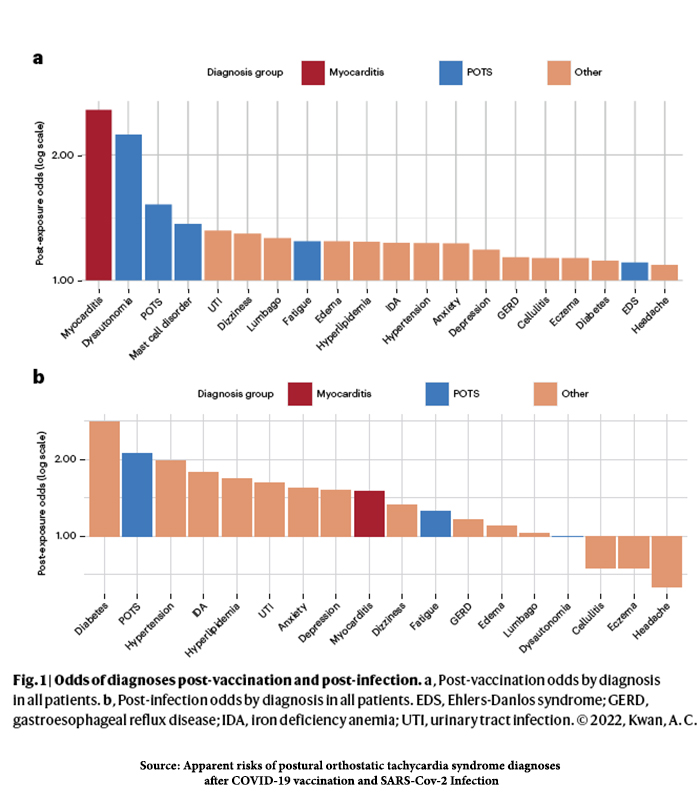Where there’s smoke, is there fire?
Long Vax, like Long COVID, is not a disease but a syndrome, a collection of signs and symptoms, by themselves, not truly diagnostic. When “clustered together,” some possible variations emerge. (You can get up to speed on Long COVID here.) Conservative estimates put the incidence of Long COVID at roughly 10% of individuals experiencing COVID; the incidence of Long Vax is challenging to pin down, but it clearly is lower.
Most reports of Long Vax involve 12 case reports or series involving very few patients. While both Long COVID and Long Vax have many symptoms, e.g., brain fog, fatigue and post-exertional malaise, the most extensive study zeroed in on one specific symptom, postural orthostatic tachycardia syndrome or POTS. We will return to POTS in a moment; let’s begin by looking at what the researchers found.
The study was based on electronic health records of outpatient encounters at Cedars Sinai Medical Center in Los Angeles – roughly 285,000 patients, 93% having been given an mRNA vaccine. A diagnosis of POTS was identified either in the 90-day interval before vaccination, thus serving as a “control,” or in the 90-day interval after immunization. Among these outpatients, without COVID
- 4526 POTS-related diagnoses were identified, 1.58% of the total outpatients.
- While 1945 patients had POTS diagnosed before vaccination, 2581 were diagnosed after vaccination, reducing the percentage of POTs associated patients with vaccination to 0.9% overall. For those who like other ratios, there was a 33% higher risk of POTS after vaccination than before.
- Another way to consider those numbers is to consider the initial pre-vaccination POTS as the baseline underlying prevalence in the population. That leaves 636 POTS patients who had a vaccination over the baseline, making the incidence of immunization-associated POTS 0.2%
- And before we awake the sleeping dragon of anti-vax sentiment, the researchers also looked at a separate group of confirmed COVID cases, none of whom were vaccinated. Here the incidence of POTS was 8%, and the number developing POTS after infection was 4.85% - a diagnosis of POTS was five-fold more likely after COVID infection than COVID vaccination.
Comments on the findings attempted to walk a fine line, acknowledging the possibility of a vaccine or COVID-related “complication” while not further promoting distrust in the vaccination. As the lead author Alan Kwan, MD, a cardiologist, said, “I’d say we were concerned about responsible messaging.”
Postural orthostatic tachycardia syndrome (POTS)
The primary symptom underlying POTS is the onset of dizziness or feeling faint when changing position, from lying or sitting to standing. When we change position, the distribution of blood in our bodies shifts, more collecting in our lower abdomen and legs, which produces a transient decline in the blood pumped by the heart that, in turn, slightly lowers our blood pressure. The relative decrease in blood reaching our brain causes faintness and dizziness. The heart responds by increasing its rate.
“The net hemodynamic effect of transition to upright posture is a 10- to 20-bpm increase in HR, a negligible change in systolic BP, and a ≈5-mm Hg increase in diastolic BP.”
Our autonomic nervous system mediates these responses through an increase in sympathetic tone (think fight or flight) and a decrease in parasympathetic tone (rest and relax). Patients are tested for POTS using a “tilt table,” basically a table you are strapped to that goes from horizontal to vertical. In patients diagnosed with POTS, the blood pressure is maintained, but the heart rate is “excessively” increased (> 30 beats/minute) for a longer period. The symptoms experienced by the patient, which may include rapid palpitations or that lightheadedness, are relieved when they lie back down.
The majority of POTS patients are women of childbearing age, and the onset of POTS frequently follows stressors, including viral illness. An interesting feature of POTS is a red-blue mottling of the legs, which are cold to touch. This mottled skin is another symptom of the dysregulation of the autonomic system. It has been a frequent accompaniment to COVID, where the mottling was ascribed to micro clots in the circulation.
An overlapping feature between Long COVID and Long Vax seen in patients with POTS is a diagnosis of anxiety. However, that may be a misinterpretation on the part of the physician. Patients with POTS, unlike those with Long COVID, do not appear to have a greater incidence of depression. A final overlapping feature of the “Longs” and POTS are memory problems, although more formal testing has suggested that the loss is more attributable to inattention than a memory deficit.
The underlying cause of POTS is unknown, although it seems clear that dysregulation of autonomics is involved. How COVID or the vaccines may “cause” that dysregulation is hypothetical. As with Long COVID, the lack of clarity in making a definitive diagnosis, coupled with the small number of individuals that may be affected, makes cleanly defining a disease, an underlying explanation, and treatment elusive at best.
Sources: Rare link between coronavirus vaccines and Long Covid–like illness starts to gain acceptance
Postural Tachycardia Syndrome (POTS) Circulation DOI: 10.1161/CIRCULATIONAHA.112.144501
Apparent risks of postural orthostatic tachycardia syndrome diagnoses after COVID-19 vaccination and SARS-Cov-2 Infection Nature Cardiovascular Research DOI: 10.1038/s44161-022-00177-8





